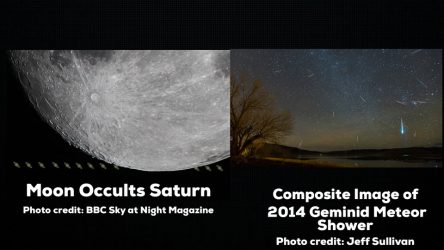
The holidays bring out the kid in all of us and we astronomers are not immune, especially if there’s a celestial light show in the offering. Remember the Great Conjunction of Jupiter and Saturn back in December 2020? I do, and what a magnificent sight it was! Well, hold on to your Santa hats and reindeer headbands because the celestial holiday magic for this year involves the Moon making Mars disappear right in front of your very eyes on the night of December 7. A week later, on December 14, you get the chance to see asteroid crumbs burning up as they plow into the Earth’s atmosphere. I’m excited just writing about all of it!
DECEMBER 7: THE MOON OCCULTS MARS
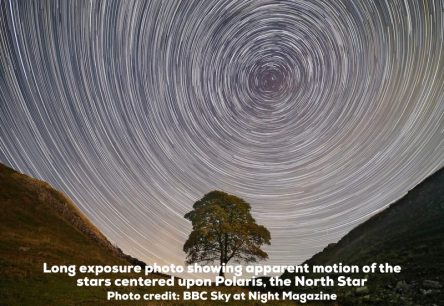 As with the Sun and the background stars, the Moon and planets appear to rise in the east, move across the sky, and then set in the west since the Earth is rotating upon its axis. Let me reemphasize that: the nightly progression of celestial objects from east to west is an apparent motion created because of the Earth rotating upon its axis. But the Moon is also physically moving within its orbit around the Earth, doing so at an average speed of some 2,288 mph. In an hour’s time, the Moon can be seen to drift eastwards by one span of its own diameter, or half a degree. Within a 24-hour period, the Moon will have shifted its position some 12-13 degrees upon the sky, in an easterly direction. In 27 days, 7 hours and 43 minutes, the Moon will have completed one full orbit around the Earth. This motion across the sky is real, as opposed to its nightly westward apparent motion, and while it is slow you can still observe it. Just go out one night and pay special note to where the Moon is in relation to the background stars within a given constellation. Go back inside and then return a few hours later, or the next night at the same time, and observe where it is then. What you will find is that the Moon really is in motion, endlessly traversing the sky in an easterly direction.
As with the Sun and the background stars, the Moon and planets appear to rise in the east, move across the sky, and then set in the west since the Earth is rotating upon its axis. Let me reemphasize that: the nightly progression of celestial objects from east to west is an apparent motion created because of the Earth rotating upon its axis. But the Moon is also physically moving within its orbit around the Earth, doing so at an average speed of some 2,288 mph. In an hour’s time, the Moon can be seen to drift eastwards by one span of its own diameter, or half a degree. Within a 24-hour period, the Moon will have shifted its position some 12-13 degrees upon the sky, in an easterly direction. In 27 days, 7 hours and 43 minutes, the Moon will have completed one full orbit around the Earth. This motion across the sky is real, as opposed to its nightly westward apparent motion, and while it is slow you can still observe it. Just go out one night and pay special note to where the Moon is in relation to the background stars within a given constellation. Go back inside and then return a few hours later, or the next night at the same time, and observe where it is then. What you will find is that the Moon really is in motion, endlessly traversing the sky in an easterly direction.
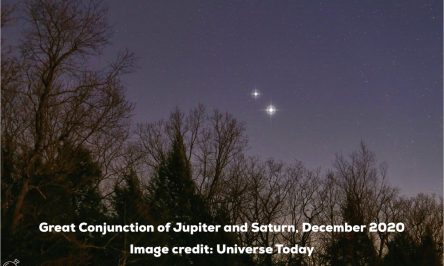 The Moon’s motion across the sky leads to two particular kinds of events that are a delight to astronomers the world over and can be appreciated by just about everyone using nothing more than their unaided eye or a basic pair of binoculars. I’ve already mentioned one of them in the very first paragraph. Conjunctions can be defined as close groupings or pairings of bright stars or planets and the Great Conjunction of Jupiter and Saturn was one of the best that we’ve had in quite a while. More often, a conjunction involves a pairing or a grouping between the Moon with a bright star or planet and we usually see a few of these each month. How close can these objects appear to be? Well in some cases, a pair of objects may appear so close together that they almost appear to be a single light source and you would need binoculars or a small telescope to split them apart visually. Every now and again a pair of objects will appear to get closer together than that and we call them “occultations”
The Moon’s motion across the sky leads to two particular kinds of events that are a delight to astronomers the world over and can be appreciated by just about everyone using nothing more than their unaided eye or a basic pair of binoculars. I’ve already mentioned one of them in the very first paragraph. Conjunctions can be defined as close groupings or pairings of bright stars or planets and the Great Conjunction of Jupiter and Saturn was one of the best that we’ve had in quite a while. More often, a conjunction involves a pairing or a grouping between the Moon with a bright star or planet and we usually see a few of these each month. How close can these objects appear to be? Well in some cases, a pair of objects may appear so close together that they almost appear to be a single light source and you would need binoculars or a small telescope to split them apart visually. Every now and again a pair of objects will appear to get closer together than that and we call them “occultations”
Okay, let’s all settle down, I know occultations sounds a bit spooky (I mean, it has the word “occult” being loud and proud in there) but all it means is that something along our line of sight has temporarily blocked our view to another object along the same line. A good example of one is whenever the new Moon blocks our view of the Sun in a total solar eclipse. Yes, the words “occultation” and “eclipse” can be used interchangeably.
The word “occult” is derived from the Latin word, “occultus” and means “hidden” or “secret”. In astronomical parlance it’s used as a verb but if you tell your co-workers that you saw your neighbors and some of their friends gathered in a circle around an altar in their backyard at midnight, wearing hooded black robes while sacrificing a goat, and you think they might be dabbling in the “occult”, then you are using it as a noun.
Each night, the Moon is gliding along in its orbit around the Earth and, as it does so, it is always occulting a few of the more distant background stars. Lunar occultations of bright stars are going to be more interesting to observe than are the fainter stars and, ideally, you would want to observe an occultation event when the Moon is at a partial phase since a full Moon’s glare can really compete with even the brightest of stars. A full Moon can also make it difficult to predict where the occulted star will reappear on the Moon’s other side. We see stars as point sources of light and when one is being occulted, they will blink out very suddenly.
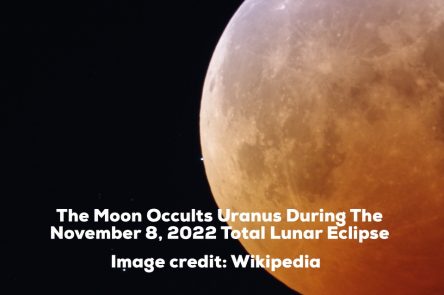 While the Moon is occulting stars all the time it is uncommon for it to do so with planets, but when it does, it is something you really want to try and see. The Earth, Moon, and all the other planets of our solar system orbit the Sun in roughly the same plane. From Earth, we see this plane projected onto our sky as the path the Sun, Moon, and planets all appear to traverse over the course of the year. We call this path, the “ecliptic”, so named by astronomers of ancient times because that’s where in the sky one would expect to see an eclipse (or occultation). Inevitably, there will be a time when the Moon’s orbital path causes it to pass in between our line of sight to a planet (or even a bright asteroid). Viewed with binoculars or a small telescope, a planet appears as a disc, rather than as a point source, consequently, an occulted planet will not suddenly blink out as a star would, it instead appears to hover over the Moon’s surface before gradually fading from view. In what is known as a “grazing occultation”, the Moon appears to skim by a planet (or other celestial object) and, with a telescope, you can actually see the planet play hide-and-seek through the gaps in the Moon’s mountains!
While the Moon is occulting stars all the time it is uncommon for it to do so with planets, but when it does, it is something you really want to try and see. The Earth, Moon, and all the other planets of our solar system orbit the Sun in roughly the same plane. From Earth, we see this plane projected onto our sky as the path the Sun, Moon, and planets all appear to traverse over the course of the year. We call this path, the “ecliptic”, so named by astronomers of ancient times because that’s where in the sky one would expect to see an eclipse (or occultation). Inevitably, there will be a time when the Moon’s orbital path causes it to pass in between our line of sight to a planet (or even a bright asteroid). Viewed with binoculars or a small telescope, a planet appears as a disc, rather than as a point source, consequently, an occulted planet will not suddenly blink out as a star would, it instead appears to hover over the Moon’s surface before gradually fading from view. In what is known as a “grazing occultation”, the Moon appears to skim by a planet (or other celestial object) and, with a telescope, you can actually see the planet play hide-and-seek through the gaps in the Moon’s mountains!
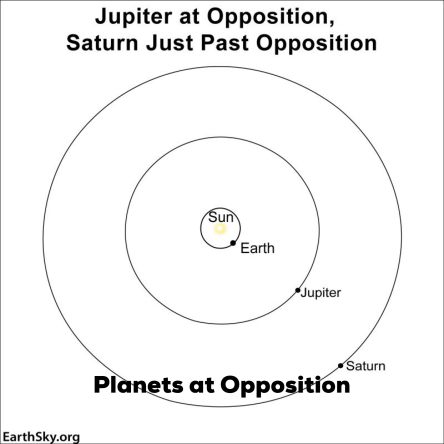
On the night of December 7, the Moon reaches full phase and the planet Mars reaches opposition on December 8. An “opposition” of a planet simply means that the Earth is at a point in its orbit where it passes in between the Sun and the planet in question. For example, seen from “above” the solar system, you would observe a configuration like this: Sun->Earth->Mars. A planet at opposition is rises at around sunset and is up all night long. It’s often at the closest point to Earth for the entire year and therefore is at its biggest and brightest. In other words, it’s a good time to observe telescopically. Mars comes into opposition roughly every two years and no two oppositions are the same due to Mars’s long, elliptical orbit. This year’s opposition is not the greatest for observing with a telescope but it’s better than the next few oppositions so, get out now and observe it. As is always the case with Mars, use as large an aperture as you can and as much magnification as your telescope will allow.
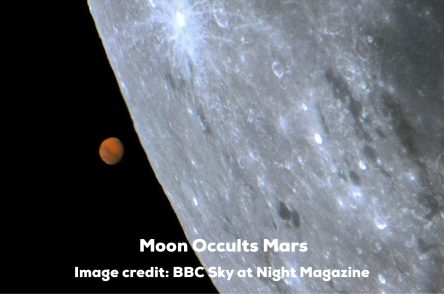
While the Moon is full this night and is not exactly perfect for observing an occultation, it is still going to be worth your while. Much of North America is going to witness this event, the exception is going to be much of the southeast. Little Rock is right along a line that represents the cutoff point for observing the complete occultation. Times for the occultation vary depending on where you are in the United States, as does where along the Moon’s edge Mars will disappear and then reappear. In Little Rock, Mars will disappear at around 9:06 PM and reappear at 9:32 PM. Now, if you have been paying attention, you will notice that is not an hour, or how long it takes for the Moon to move a full diameter. From Little Rock, we will see Mars become occulted along the Moon’s far southern hemisphere and, consequently, it will pop back out pretty quickly.
While the occultation can be seen with the unaided eye, I highly recommend that you use binoculars or a small telescope for the very best experience. Thanks to the Central Arkansas Astronomical Society, you can now check out telescopes from the Central Arkansas Library System (all branches) just like you can a book, so you might want to grab one ASAP.
DECEMBER 14TH: THE GEMINID METEOR SHOWER
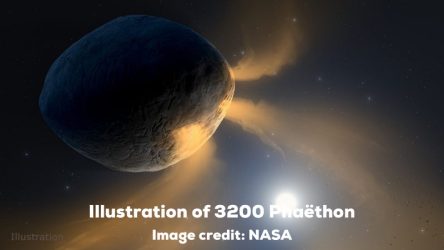 Of the various annual meteor showers, we always close out the year with the best, the Geminids, whose numbers rival those of the Perseids in August. Under the very best of conditions, it is possible to see 120 per hour. But that’s assuming a lot about your viewing conditions and prime conditions are rarely ever met and this year, the biggest problem will be a bright waning, Moon. But all is not lost, it will still be possible to see a few of these bright meteors.
Of the various annual meteor showers, we always close out the year with the best, the Geminids, whose numbers rival those of the Perseids in August. Under the very best of conditions, it is possible to see 120 per hour. But that’s assuming a lot about your viewing conditions and prime conditions are rarely ever met and this year, the biggest problem will be a bright waning, Moon. But all is not lost, it will still be possible to see a few of these bright meteors.
For most meteor showers, what we are seeing are the sand grain-sized bits of comet dust burning up in our atmosphere but with the Geminids the parent source is an asteroid named 3200 Phaethon. Comets are primarily ice while asteroids are rocky material and the crumbs left behind in the wake of the passage of 3200 Phaethon are more pebble-sized than dust grain-sized, as a result they tend to produce much brighter meteor streaks across the sky. That’s good because some of them can be bright enough to overcome the Moon’s glare.
My advice for this year is to get out on the night of December 13 and continue watching for as long as you can until the Moon rises during the wee hours of December 14, the predicted peak. Observe from outside the city, under as dark a sky conditions as you can find (I cannot stress this enough). To find a good observing site here in the state, please visit the Arkansas Natural Sky Association’s website for a list of suggested locations: https://darkskyarkansas.org
Also, be sure and bundle up, bring snacks, and warm beverages.
Happy Holidays and remember to keep looking up in both awe and wonder.